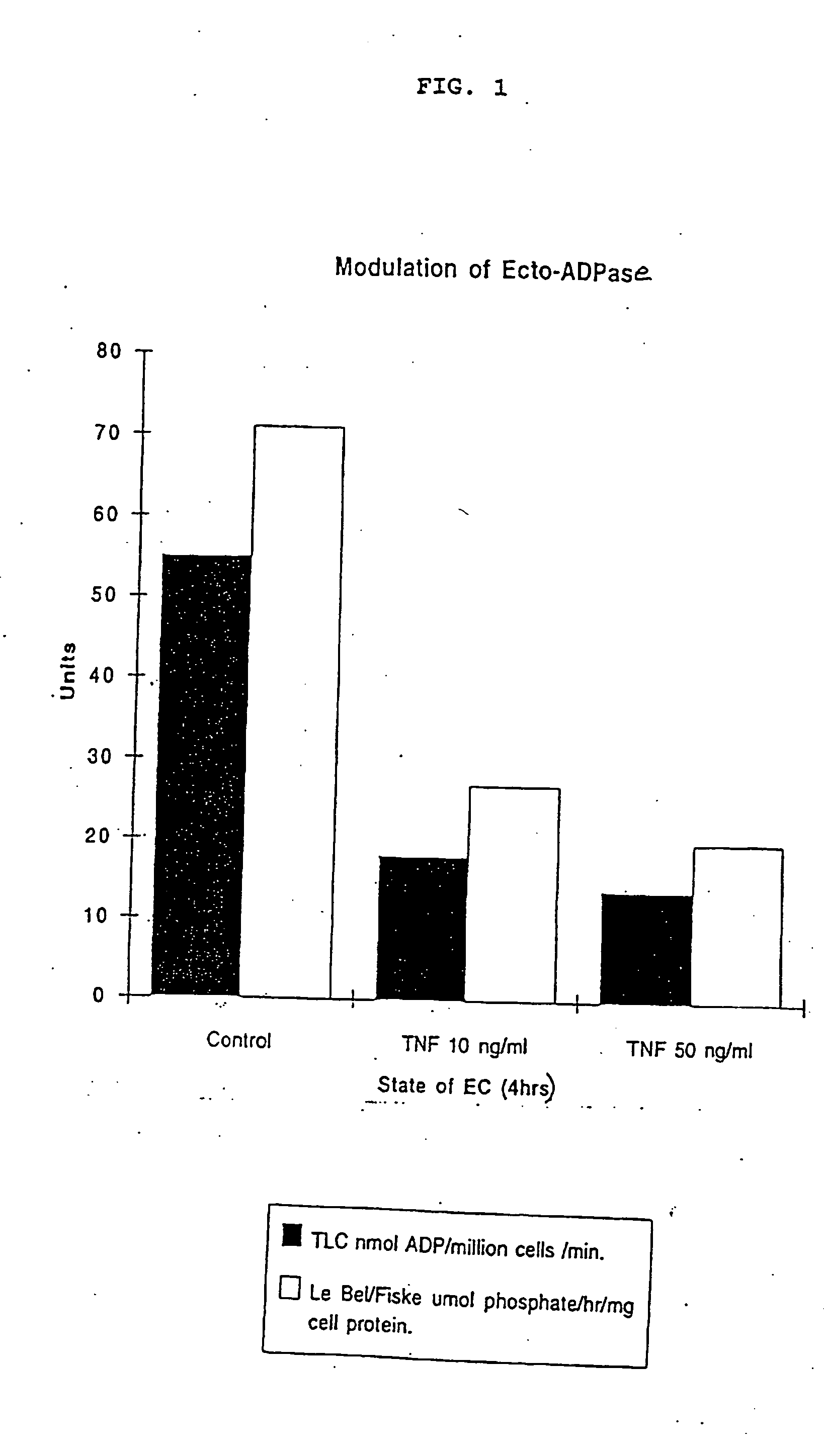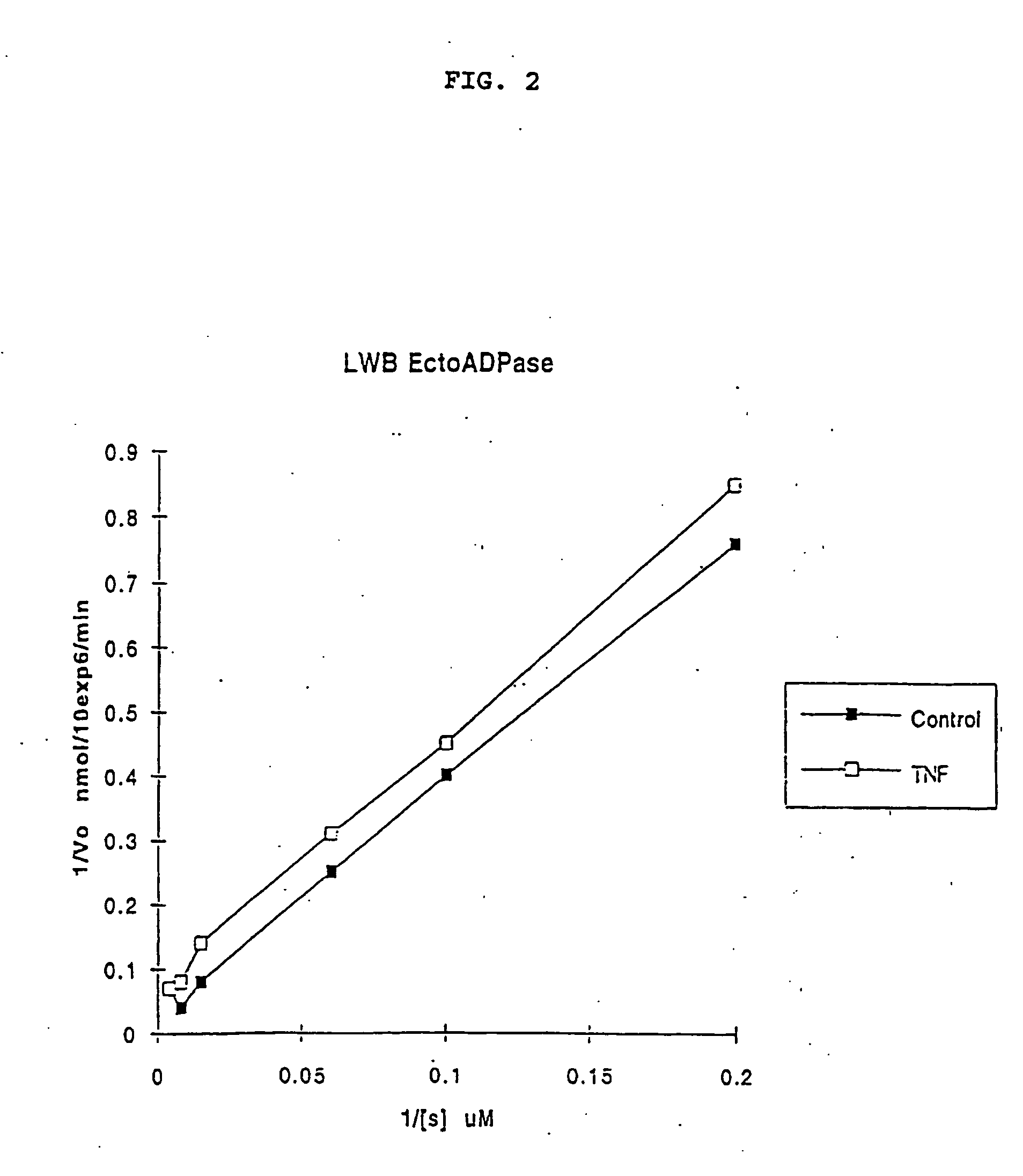ATP diphosphohydrolase (CD39) gene therapy for inflammatory or thrombotic conditions and transplantation and means there for
a technology of atp diphosphohydrolase and inflammatory or thrombotic conditions, which is applied in the field of gene therapy and tissue and organ transplantation, can solve the problems of affecting the viability of implanted tissues and organs, thrombosis formation in the vasculature of grafts, and largely unregulated mechanisms, so as to reduce thrombosis and moderate thrombosis. complications, the effect of reducing the number of patients
- Summary
- Abstract
- Description
- Claims
- Application Information
AI Technical Summary
Benefits of technology
Problems solved by technology
Method used
Image
Examples
example 1 (
EXAMPLE 1(d)
[0175] PAEC ecto-ATP diphosphohydrolase kinetics post-activation of intact cells were also determined by TLC: Vmax 15 nmolADP / 1.times.106 cells / min (Km 70 .mu.M). Reciprocal plots suggest an uncompetitive inhibition process. This novel observation is in keeping with either an inhibitor binding to the enzyme-substrate complex (but not the free enzyme itself) or a process of inhibition which disturbs the enzyme catalytic function independent of substrate binding. (FIG. 2).
EXAMPLE 2(A)
[0176] Oxidative stress inhibits porcine endothelial cell ecto-ATP diphosphohydrolase.
[0177] Incubation of PAEC with HOOH at concentrations of 5 .mu.M and 10 .mu.M which are potentially produced by activated endothelial cells, in the absence of catalase activity, has a significant effect on the activity of the ecto-ATP diphosphohydrolase comparable and non-additive to that observed following cell activation with cytokines. FIG. 3 depicts loss of enzyme activity after treatment with 5 uM HOO...
example 2 (
EXAMPLE 2(c)
[0181] A loss of ecto-ATP diphosphohydrolase activity on PAEC is demonstrated as a result of TNF.alpha. activation and following incubation with and perturbation of endothelial cells by HOOH (peroxide 5 .mu.M) and by Xanthine Oxidase / Xanthine (XO / X at combinations of 200 .mu.M xanthine and typically 100 mU / ml of xanthine oxidase which is phosphate free) in vitro. XO / X cause oxidative damage to cells and their membrane proteins and lipids by both peroxide and superoxide radicals. In the presence of iron, toxic hydroxyl radicals are formed. Note the late decrease in enzyme activity following exposure to oxygen radicals (FIG. 5).
example 3
[0182] Antioxidant strategies with SOD / catalase supplementation in the systems tested likewise are shown to be protective in preserving endothelial cell ecto-ATP diphosphohydrolase activity following activation processes. Superoxide dismutase (Cu—Zn form from Bovine RBC) removes oxygen radicals, and was used at a concentration of 330 u / ml. Catalase degrades HOOH, and a preparation from bovine liver was used at a final concentration of 1,000 u / ml.
[0183] Zinc has protean effects on cell membranes but can also serve as a potent antioxidant as potentially demonstrated here at concentrations previously documented to maintain porcine endothelial integrity following cytokine perturbation in vitro. Supplementation in these systems likewise appear to be protective in preserving endothelial cell ecto-ATP diphosphohydrolase activity (FIG. 6).
PUM
| Property | Measurement | Unit |
|---|---|---|
| molecular mass | aaaaa | aaaaa |
| molecular mass | aaaaa | aaaaa |
| concentrations | aaaaa | aaaaa |
Abstract
Description
Claims
Application Information
 Login to View More
Login to View More - R&D
- Intellectual Property
- Life Sciences
- Materials
- Tech Scout
- Unparalleled Data Quality
- Higher Quality Content
- 60% Fewer Hallucinations
Browse by: Latest US Patents, China's latest patents, Technical Efficacy Thesaurus, Application Domain, Technology Topic, Popular Technical Reports.
© 2025 PatSnap. All rights reserved.Legal|Privacy policy|Modern Slavery Act Transparency Statement|Sitemap|About US| Contact US: help@patsnap.com



